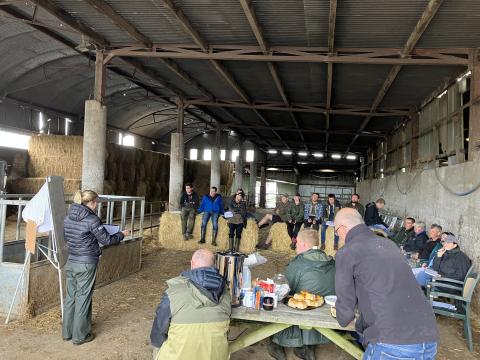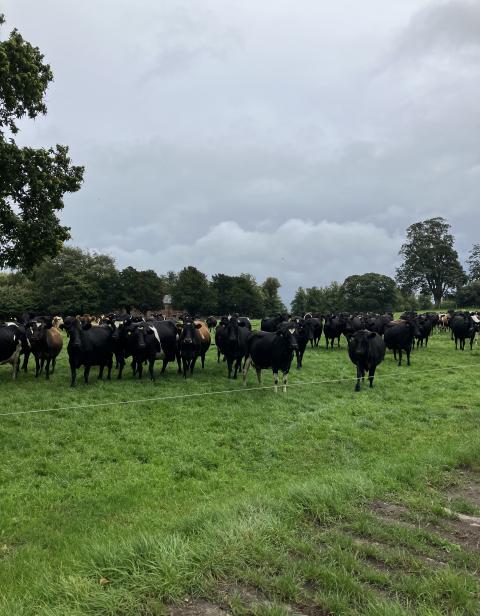2 November 2023
When a Flintshire dairy farm introduced once-a-day (OAD) milking it was a permanent switch the business made to improve work-life balance but reduced milking frequency can also be used as a temporary measure to manage herd health or aid expansion.
David and Carol Williams, their daughter, Vicky, and sister-in-law Sue Pope, run a spring calving herd on a grass-based system at Clawdd Offa, Northop.
They recently hosted a Farming Connect open day when the pros and cons of OAD milking were discussed. As part of the day, David took us for a farm walk looking to look at the cows, grazing infrastructure and discuss grass and some new herbal leys trialled on farm this summer, yet not all of the team at Clawdd Offa were convinced with the multi species swards.
At Clawdd Offa, the switch made to OAD milking in 2011 has been a positive move, a decision made initially as a lifestyle choice because, at 50, David didn’t want to continue milking twice a day (TAD).
There was also an element of necessity; to access one half of the grazing platform, cows need to cross a very busy commuter road close to the North Wales expressway, a job that requires three people.
It is one the family can get done in less than five minutes but making this work twice a day became increasingly difficult.
A better work-life balance has been achieved from OAD milking but what the family hadn’t anticipated was the uplift in milk solids - cows produced an average of 15-20% more.
“Our predicted production for this year will be around 400kg milk solids per cow, over 5,000 litres of standard milk,’’ said David.
It is a system they have been operating for 12 years, but OAD can also be used as a tactical short-term response to different factors.
Sean Chubb, Pasture to Profit consultant at LIC UK, a speaker at the Farming Connect event, said in can be a useful measure for aiding herd expansion.
For example, a farmer might take on neighbouring land which allows cow numbers to increase from 100 to 200, yet the milking parlour and facilities are only set up for 100 cows.
“An option could be to milk 100 in the morning and 100 in the afternoon until new infrastructure is in place,’’ Mr Chubb advised.
It can also be used as a tool to manage animal health and body condition at pinch points in the lactation, including in the first three weeks post-calving when milk production is increasing and cows struggle to achieve sufficient feed intakes to match that need.
If milking pressure is reduced at this point, fertility in the next breeding cycle can often improve, said Mr Chubb.
The trade-off might be a drop in milk production, perhaps 1.5% less kilogrammes of milk solids over the lactation, but similar fluctuation will be seen from year to year from differing weather conditions.
If a cow has had a difficult calving - perhaps she has had twins, retained her cleansings or is thin - milking once daily through the mating period will aid fertility.
“We quite often see cows that have been put on that system during the mating season achieving higher conception rates than those that have not had injuries during birth but are milked twice a day,’’ said Mr Chubb.
Reduced milking frequency is also useful for enabling body condition score gains in the last two months of the lactation, when milk production losses will be noticed less as yield is already tailing off at this point.
For farmers considering a more permanent shift to OAD, labour is often the underlying consideration, but Mr Chubb warned against this as a blunt tool for running a higher number of cows per labour unit.
“It might put too much pressure on staff, making their lives difficult, and the business could find itself having to manage a regular turnover of staff.’’
There are definite labour savings from OAD milking though.
A study in New Zealand looked at the average full-time equivalent labour unit on different systems – on TAD one labour unit was needed per 139 cows while on OAD it was 157 – 20 additional cows.
But the study was based on herds at grass 365 days a year, therefore those figures might not apply to UK systems where housing is more of a feature, Mr Chubb pointed out.
Cows will take longer to milk on a OAD system – an average of 3.5 hours in a 200-cow herd compared to three hours for that number milked TAD – but savings are made on items such as cluster liners as they get less use and on sundries like dairy chemicals because washing down is only done once.
Cost of production is likely to be less too – for example if cows are being fed concentrates at each milking, they will only need that feed once a day.
“But there is a lower output from cows on OAD milking so reductions in costs are needed to offset that loss,’’ said Mr Chubb.
For farms that have converted to dairying but don’t have the ideal topography for that – for example it might have steep land – it can be sensible to opt for OAD milking.
“Cows will be walking off a lot of litres if they are walking up hills so it is beneficial if they only need to come to the parlour once a day,’’ said Mr Chubb.
Higher somatic cell counts (SCCs) can be an issue, particularly when OAD is used as a short-term measure if, for example, there is a history of staph aureus in the herd.
“That might flare up so you need to make a note of the problem cows and manage those,’’ Mr Chubb advised.
“Even if making the switch to OAD is permanent you might see an increase in SCC in the first couple of years but it can be reduced back down to normal levels as happened at Clawdd Offa.’’
If the switch to OAD doesn’t work out, it is a straightforward process to transition back to TAD, Mr Chubb added.


